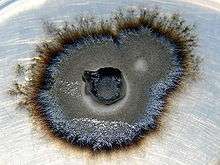Ericoid mycorrhiza



The ericoid mycorrhiza is a mutualistic symbiosis formed between members of the plant family Ericaceae and several lineages of fungi. The symbiosis represents an important adaptation to acidic and nutrient poor soils that species in the Ericaceae typically inhabit,[2] including boreal forests, bogs, and heathlands. Molecular clock estimates suggest that the symbiosis originated approximately 140 million years ago.[3]
Structure and function
Ericoid mycorrhizas are characterized by fungal coils that form in the epidermal cells of the fine hair roots of ericaceous species.[4] Ericoid mycorrhizal fungi establish loose hyphal networks around the outside of hair roots, from which they penetrate the walls of cortical cells to form intracellular coils that can densely pack individual plant cells.[4] However, the fungi do not penetrate plasma membranes of plant cells. Evidence suggests that coils only function for a period of a few weeks before the plant cell and fungal hyphae begin to degrade.[4]
The coil is the site where fungi exchange nutrients obtained from the soil for carbohydrates fixed through photosynthesis by the plant. Ericoid mycorrhizal fungi have been shown to have enzymatic capabilities to breakdown complex organic molecules.[5][6] This may allow some ericoid mycorrhizal fungi to act as saprotrophs. However, the primary function of these enzymatic capabilities is likely to access organic forms of nutrients, such as nitrogen, whose mineralized forms are in very limiting quantities in habitats typically occupied by ericaceous plants.[6]
Fungal taxonomy
The majority of research with ericoid mycorrhizal fungal physiology and function has focused on fungal isolates morphologically identified as Rhizoscyphus ericae, in the Ascomycota order Helotiales. The application of DNA sequencing to fungal isolates and clones from environmental PCR has uncovered diverse fungal communities in ericoid roots.[7][8][9][10] In addition to Rhizoscyphus ericae, it is currently recognized that culturable Ascomycota such as Meliniomyces (closely allied with Rhizoscyphus ericae) and Oidiodendron maius form ericoid mycorrhizas. A variety of other fungi in the Ascomycota have also been isolated or detected through direct PCR-based methods from ericoid roots, but their ability to form coils has not been verified and many are likely endophytes or parasites. Sebacina species in the phylum Basidiomycota are also recognized as frequent, but unculturable, associates of ericoid roots.[7][8] Sebacina species are known to form other forms of mycorrhizas with non-ericoid plants, however their status as ericoid mycorrhizal fungi is unclear because they have not been verified to form intracellular coils.[4]
Geographic and host distribution
The ericoid mycorrhizal symbiosis is widespread. Ericaceae species occupy at least some habitats on all continents except Antarctica.[11] A few lineages within the Ericaceae do not form ericoid mycorrhizas, and instead form other types of mycorrhizas, including manzanita (Arctostaphylos), madrone (Arbutus), and the Monotropoidiae.[4] The geographic distribution of many of the fungi is uncertain, primarily because the identification of the fungal partners has not always been easy, especially prior to the application of DNA-based identification methods.[4] Fungi ascribed to Rhizoscyphus ericae have been identified from Northern and Southern Hemisphere habitats, but these are not likely all the same species. Some studies have also shown that fungal communities colonizing ericoid roots can lack specificity for different species of ericoid plant, suggesting that at least some of these fungi have a broad host range.[9][10]
Economic significance
Ericoid mycorrhizal fungi form symbioses with several crop and ornamental species, such as blueberries, cranberries and Rhododendron. Inoculation with ericoid mycorrhizal fungi can influence plant growth and nutrient uptake.[12] However, much less agricultural and horticultural research has been conducted with ericoid mycorrhizal fungi relative to arbuscular mycorrhizal and ectomycorrhizal fungi.


External links
References
- ↑ Midgley, D. J.; Chambers, S. M.; Cairney, J. W. G. (2002). "Spatial distribution of fungal endophyte genotypes in a Woollsia pungens (Ericaceae) root system". Australian Journal of Botany. 50 (5): 559. doi:10.1071/BT02020.
- ↑ Cairney, J. W. G. and A. A. Meharg. 2003. Ericoid mycorrhiza: a partnership that exploits harsh edaphic conditions. European Journal of Soil Science 54: 735–740. doi:10.1046/j.1351-0754.2003.0555.x.
- ↑ Cullings, K. W. 1996. Single phylogenetic origin of ericoid mycorrhizae within the Ericaceae. Canadian Journal of Botany 74: 1896-1909.
- 1 2 3 4 5 6 Smith, S. E. and D. J. Read. 2008. Mycorrhizal Symbiosis, Third Edition. Academic Press.
- ↑ Cairney, J. W. G., and R. M. Burke.1998. Extracellular enzyme activities of the ericoid mycorrhizal endophyte Hymenoscyphus ericae (Read) Korf & Kernan: their likely roles in decomposition of dead plant tissue in soil. Plant and Soil 205: 181-192.
- 1 2 Read, D. J., J. R. Leake, and J. Perez-Moreno. 2004. Mycorrhizal fungi as drivers of ecosystem processes in heathland and boreal forest biomes. Canadian Journal of Botany 82: 1243-1263.
- 1 2 Allen, T. R., T. Millar, S. M. Berch, and M. L. Berbee. 2003. Culturing and direct DNA extraction find different fungi from the same ericoid mycorrhizal roots. New Phytologist 160:255-272.
- 1 2 Selosse, M. A., S. Setaro, F. Glatard, F. Richard, C. Urcelay, and M. Weiss. 2007. Sebacinales are common mycorrhizal associates of Ericaceae. New Phytologist 174:864-878.
- 1 2 Kjoller, R., M. Olsrud, and A. Michelsen. 2010. Co-existing ericaceous plant species in a subarctic mire community share fungal root endophytes. Fungal Ecology 3:205-214.
- 1 2 Walker, J. F., L. Aldrich-Wolfe, A. Riffel, H. Barbare, N. B. Simpson, J. Trowbridge, and A. Jumpponen. 2011. Diverse Helotiales associated with the roots of three species of Arctic Ericaceae provide no evidence for host specificity. New Phytologist 191: 515-527.
- ↑ http://www.mobot.org/MOBOT/research/APweb/welcome.html
- ↑ Scagel, C. F. 2005 Inoculation with ericoid mycorrhizal fungi alters fertilizer use of highbush blueberry cultivars. HortScience 40: 786-794.
Coordinates: 14°07′35″S 69°58′04″W / 14.1264°S 69.9678°W